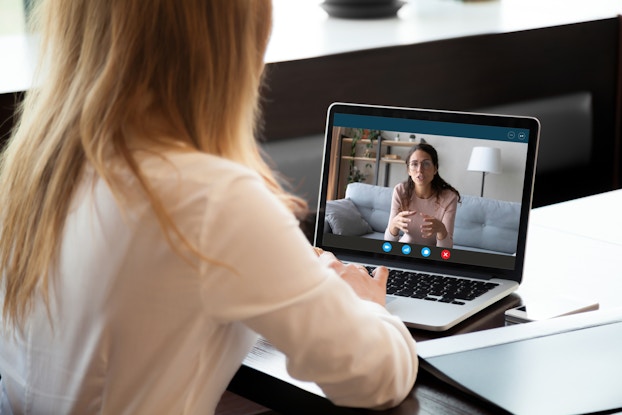
What exactly is a virtual event? It might be easier to say what they are not. Virtual events are no longer the same old, one-dimensional lectures people have hosted online for years. A virtual event takes it a huge step further. Just as you would physically attend a multi-session trade show or expo with exhibitors and interactive panel discussions, you can now do so online.
In fact, virtual event software makes two-way interaction the priority and strives to give attendees more opportunities to connect with presenters, sponsors and one another. Your virtual event is only as limited as your imagination—think live Q&A, networking happy hours, virtual booth exhibitions and even event breakout rooms.
If the cost has so far prevented your small business from hosting in-person events, virtual events may be a better fit for your budget, eliminating overhead costs (renting space, travel and catering).
Think virtual events might be for you? Here’s how to do it right.

Planning, strategizing and testing
Start by deciding what kind of virtual event you want to host and what elements you want to offer. Your options include:
- How-to classes and demonstrations
- Training courses and workshops
- Facility tours
- Interviews and panel discussions
- Performances such as concerts, comedy acts or lectures
- Networking
- Product launches
- Exhibitor booths
Most webinar platforms have now added virtual event elements due to overwhelming demand. Over the past few months, virtual event platforms such as 6Connex, have seen their businesses grow by 1000%.
Depending on your goals, virtual events can last one hour, one day or span several days. The length of the session is one important difference from a live event, according to Convince & Convert Consulting. While a one-hour session in person is the norm, online you no longer have a “captured audience,” so keeping the sessions shorter (30-45 minutes is recommended, but shorter works as well) is a good idea.
Because interaction with your attendees is important to attendees, it’s vital you include chat/Q&A functions in every element. And make sure you test them before going live.
Events, live or virtual, are all about networking.
Engaging the audience
The success of your virtual event depends on a lot of factors, but keeping the audience engaged ranks at the top. Unlike an in-person event, it’s much easier for an attendee to “tune out” from a virtual event and get distracted. Cvent, a leader in global meeting software solutions, suggests incorporating these elements to keep your audience attentive:
- Compelling content. Because an online event lacks the “non-business” elements of an event (such as the chance to get out of the office), your content needs to be especially appealing — offering “can’t miss” information or speakers.
- Excellent production quality. The quality of the technology, the camera views and the sound are essential to the success of your event. Attendees expect your event to be nearly seamless.
- Live polling. Being able to poll the audience is an important tool that keeps the audience engaged. Speakers can even call out to specific attendees by name.
- Push notifications. Once attendees enroll for your virtual event, ask permission to send them SMS messages. Then send reminders of upcoming sessions, fun facts about the event and even coupons for event product swag.
- Live Q&A. Be sure to include Q&A time after every session, just as you would in an in-person event.
- FAQs and tips. Prepare attendees for your virtual event by explaining how to attend sessions online, how to navigate the event and, of course, a list of your exhibitors. Think of it as a virtual event program.
- Networking. Events, live or virtual, are all about networking. Make sure you create networking “rooms” where attendees with like interests can gather and chat with speakers after a session. Send push notifications after each session, such as “Want to continue the discussion? Head over to our networking chat room at this link.”
- Live and on-demand. Attendees may want to view content at their own leisure, so make sessions your live sessions available for on-demand viewing.
- Offer swag. You can offer virtual swag by sending emails to attendees ahead of your event. Sponsors and exhibitors should create links where attendees can grab coupons, downloads and more.
- Think outside the box. What else can you offer your virtual audience to get them excited about your event? Know a magician willing to do a fun session with attendees? How about a contest or game where attendees can win prizes?
How did you do?
After each session, send a quick survey asking attendees what they did or didn’t like about a specific class or presentation. Once the entire event is completed follow up with a more comprehensive survey. Have them rank sessions in order of preference and how much they learned from them. Keep the survey short and mostly multiple choice so the attendee is more likely to complete the survey. Consider offering an incentive for filling out the survey, such as a chance to win a gift card. Think of each event as a learning experience for your business on what to do better next time. While the future of in-person events is still cloudy, creating virtual events continues to be a great marketing tool and method to reach a wider market for your growing business.
Top virtual event platforms
Here are some top platforms for you to consider:
CO—is committed to helping you start, run and grow your small business. Learn more about the benefits of small business membership in the U.S. Chamber of Commerce, here.






